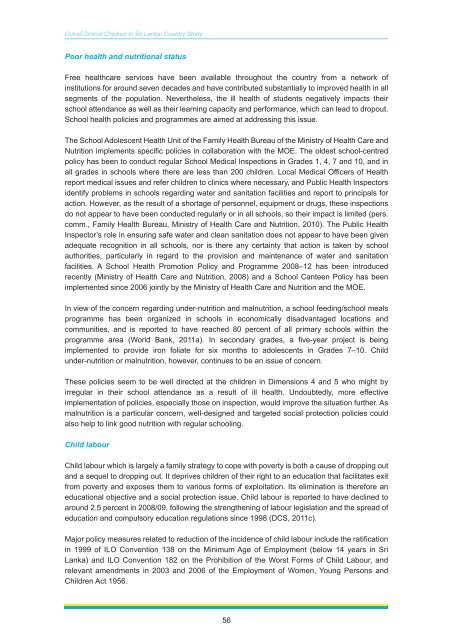Sri Lanka - Institut de statistique de l'Unesco
Sri Lanka - Institut de statistique de l'Unesco
Sri Lanka - Institut de statistique de l'Unesco
Create successful ePaper yourself
Turn your PDF publications into a flip-book with our unique Google optimized e-Paper software.
Out-of-School Children in <strong>Sri</strong> <strong>Lanka</strong>: Country Study<br />
Poor health and nutritional status<br />
Free healthcare services have been available throughout the country from a network of<br />
institutions for around seven <strong>de</strong>ca<strong>de</strong>s and have contributed substantially to improved health in all<br />
segments of the population. Nevertheless, the ill health of stu<strong>de</strong>nts negatively impacts their<br />
school attendance as well as their learning capacity and performance, which can lead to dropout.<br />
School health policies and programmes are aimed at addressing this issue.<br />
The School Adolescent Health Unit of the Family Health Bureau of the Ministry of Health Care and<br />
Nutrition implements specific policies in collaboration with the MOE. The ol<strong>de</strong>st school-centred<br />
policy has been to conduct regular School Medical Inspections in Gra<strong>de</strong>s 1, 4, 7 and 10, and in<br />
all gra<strong>de</strong>s in schools where there are less than 200 children. Local Medical Officers of Health<br />
report medical issues and refer children to clinics where necessary, and Public Health Inspectors<br />
i<strong>de</strong>ntify problems in schools regarding water and sanitation facilities and report to principals for<br />
action. However, as the result of a shortage of personnel, equipment or drugs, these inspections<br />
do not appear to have been conducted regularly or in all schools, so their impact is limited (pers.<br />
comm., Family Health Bureau, Ministry of Health Care and Nutrition, 2010). The Public Health<br />
Inspector’s role in ensuring safe water and clean sanitation does not appear to have been given<br />
a<strong>de</strong>quate recognition in all schools, nor is there any certainty that action is taken by school<br />
authorities, particularly in regard to the provision and maintenance of water and sanitation<br />
facilities. A School Health Promotion Policy and Programme 2008–12 has been introduced<br />
recently (Ministry of Health Care and Nutrition, 2008) and a School Canteen Policy has been<br />
implemented since 2006 jointly by the Ministry of Health Care and Nutrition and the MOE.<br />
In view of the concern regarding un<strong>de</strong>r-nutrition and malnutrition, a school feeding/school meals<br />
programme has been organized in schools in economically disadvantaged locations and<br />
communities, and is reported to have reached 80 percent of all primary schools within the<br />
programme area (World Bank, 2011a). In secondary gra<strong>de</strong>s, a five-year project is being<br />
implemented to provi<strong>de</strong> iron foliate for six months to adolescents in Gra<strong>de</strong>s 7–10. Child<br />
un<strong>de</strong>r-nutrition or malnutrition, however, continues to be an issue of concern.<br />
These policies seem to be well directed at the children in Dimensions 4 and 5 who might by<br />
irregular in their school attendance as a result of ill health. Undoubtedly, more effective<br />
implementation of policies, especially those on inspection, would improve the situation further. As<br />
malnutrition is a particular concern, well-<strong>de</strong>signed and targeted social protection policies could<br />
also help to link good nutrition with regular schooling.<br />
Child labour<br />
Child labour which is largely a family strategy to cope with poverty is both a cause of dropping out<br />
and a sequel to dropping out. It <strong>de</strong>prives children of their right to an education that facilitates exit<br />
from poverty and exposes them to various forms of exploitation. Its elimination is therefore an<br />
educational objective and a social protection issue. Child labour is reported to have <strong>de</strong>clined to<br />
around 2.5 percent in 2008/09, following the strengthening of labour legislation and the spread of<br />
education and compulsory education regulations since 1998 (DCS, 2011c).<br />
Major policy measures related to reduction of the inci<strong>de</strong>nce of child labour inclu<strong>de</strong> the ratification<br />
in 1999 of ILO Convention 138 on the Minimum Age of Employment (below 14 years in <strong>Sri</strong><br />
<strong>Lanka</strong>) and ILO Convention 182 on the Prohibition of the Worst Forms of Child Labour, and<br />
relevant amendments in 2003 and 2006 of the Employment of Women, Young Persons and<br />
Children Act 1956.<br />
56

















